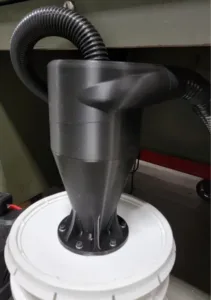
Just the other day I was sweeping my shop floor, and cleaning wood chips off my workbench when a thought occurred, “Do I need to get a dust collector?”. Now, this isn’t an original thought, I have had the question many times before, but this time was different. I had finally had enough of spending 15-20 minutes at the end of my shop time trying to clean up all the chips strewn about all over the shop. I decided to do a little research and see what I could find. In short, I was able to come up with this.
Yes. If you spend any amount of time in the shop, getting some kind of dust collection system is a good idea. Large wood chips are a nuisance and have their dangers, but the real danger is the fine wood dust that is created which poses a serious health risk. Exposure to fine wood dust can cause various respiratory issues as well as the potential for cancer. Click here to view more information about the dangers of wood dust.
If this was a surprise to you, don’t fret. I was in the same boat because I had no idea that the fine dust particles posed any kind of danger to my lungs, especially not potentially cancer-causing effects. Read on to find out more about a few other questions I had when researching this topic.
What are the Different Dust Collection Options?
For wood dust collection, there are a few options you can go with. Which option you choose will be determined by a few different factors such as budget, shop space, and how fine the dust is that you are trying to collect. We will dive into the most popular types of dust collection for woodworkers, and look into some of the benefits and disadvantages of each.
Shop VAC
Using a shop VAC or similar vacuum style is typically the first dust collection system people start with and is probably the most common option for hobby woodworkers. One of the main pros to using a shop vac is the price. They are the cheapest option and are widely available at any big box retailer.

They can also be paired with a cyclone filter which extends the life of your vacuum filter and makes dust collection more efficient. A downside to the shop vac is that the filtration system is nowhere near as advanced as what you would see on a dedicated dust collector. This is one of the factors that contribute to a dust collector being more expensive than a shop VAC. If you are just trying to collect dust in a smaller shop, a shop VAC with a cyclone filter add-on is the way to go. However, if you have a larger shop or are just interested in filtering out smaller dust particles, you will probably be interested in one of the dedicated dust collection systems below.

Single Stage
A single-stage dust collector essentially performs the same function as a shop vac. There is a blower motor that pulls air (dust) into a collection area, where gravity forces larger chunks of debris to the bottom of the collection area. The air is then forced out of the collection container through a filter, which captures finer particles that didn’t fall to the bottom. The main difference between a dedicated single-stage dust collector and a shop VAC is the type of filtration. A dust collector is typically going to be able to filter out much finer particles than your typical shop VAC. A dust collector can also provide much more CFM than a shop VAC.
The downsides to having a dedicated dust collector are its size and price. They tend to have large collection bags and are much more expensive as well. You get what you pay for though, which in this case is larger collection capabilities and finer dust filtration. If you have the extra space and cash to spend on a dedicated dust collection system, this would be the next step up from the shop VAC route.
Two Stage
The next step up from the single-stage dust collection is the two-stage system. This has everything that the single-stage system has, but with an added mechanical dust separator, called a cyclone. This is the same thing we mentioned when discussing the shop VAC. The cyclone filter works by forcing all the larger pieces of debris to fall into a collection container before pushing the air to the second stage where the micron filter is contained. The air that is then forced to the second stage only contains the finer particles that gravity wasn’t able to keep down in the first stage by the cyclone filter.
This method is the best way to collect dust as it allows the filter to perform its function better and more efficiently. The downside to the two-stage dust collector is an increased cost and having to take up even more shop space. If you are in a larger shop or will be performing woodworking professionally, this is going to be the route you want to go.
How Much CFM Do I Need?
The amount of CFM you need for dust collection varies depending on your setup and the tools you plan on connecting to. The CFM requirement can range anywhere from 150-800 CFM per tool. We will give some brief considerations on CFM required and what you should think about when looking into a dust collection system.
CFM vs. FPM
The most common values for dust collectors are listed in CFM (cubic feet per minute). However, this is not the only value that you should pay attention to. There is another important value that you should also pay attention to and that is FPM (feet per minute). CFM is the volume of air, and FPM is the speed of that air. The amount of CFM you need is determined by the tool you are connected to and FPM is determined by the size of the hose. A general recommendation for FPM is to be above 3500 FPM.
Dust Collection Setup
When planning your shop dust collection, there are two main routes you can go; either a single hookup point that you move to whichever tool you are currently using or a multi-hose system utilizing ducts that are connected to different points along your workshop. A single hookup system is the easiest to design for because you simply design for the one tool that has the greatest CFM requirement and it will then be enough for all of your tools. When you begin to add ductwork to your shop, you have to start accounting for things like static pressure. This is where lengths of hoses/ducts and their diameters can get a little tricky. We recommend visiting this article by woodmagazine. They do a great job of explaining how to calculate CFM and even account for the length of the ductwork and different diameters. Their article comes with worksheets and instructions on how to calculate the necessary CFM for your shop.


